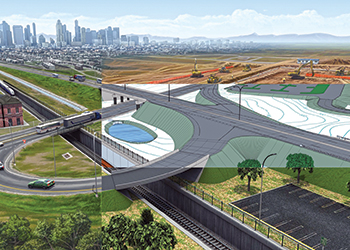
 The Sheikh Jaber Al Ahmad Al Sabah Causeway ... $2.6 billion project.
The Sheikh Jaber Al Ahmad Al Sabah Causeway ... $2.6 billion project.
Aconex’s collaboration platform allows various construction teams engaged on a development to quickly share and locate critical project information.
Aconex, whose cloud platform connects global teams on construction and engineering projects, said its key solutions have been deployed for a major causeway project in Kuwait.
Korea’s Hyundai Engineering & Construction Company and Kuwait-based Combined Group Contracting Company (CGC) are designing and building the $2.6-billion Sheikh Jaber Al Ahmad Al Sabah Causeway using Aconex solutions.
Aconex was proposed by the two contractors and approved by the project owner, the Kuwait Ministry of Public Works, says the company.
One of the largest and most prestigious transportation infrastructure projects in the Gulf region, the causeway will connect Kuwait City with an area across Kuwait Bay known as the Subiya New Town or the City of Silk.
The new settlement, which is expected to be completed in 2035, is planned as a major stop on China’s proposed “One Belt One Road” initiative, which is intended to revive the ancient Silk Road trade route.
By shortening the distance between Kuwait City and Subiya from 104 km to just 36 km, the new throughway will trim travel times from 90 minutes to less than 30 minutes.
In November 2012, the Kuwait Ministry of Public Works signed a contract with a consortium of Hyundai and CGC to design and build the causeway.
A combination of low-level bridges and embankments, the project also includes 26 separate buildings and two artificial islands of 30 hectares each designed to enhance the scenic value of the drive.
Other members of the consortium include French group Systra; Aecom in Hong Kong; Dar Al Handasah (Shair and Partners), headquartered in Beirut, Lebanon; TYLN International; and SSH International.
Work began in November 2013. As the project team ramped up, members in Kuwait, France, Egypt, Lebanon, and San Francisco (US) all required immediate access to project information.
According to Mai Al Messad, the project engineer, the number of daily transmittals of inspection requests, checklists, approvals, and progress reports had already risen into the hundreds.
“We needed to manage the transmittals and to securely share documents with different organisations across multiple geographies,” remarks Al Messad.
“It was critical for us to locate and retrieve project information quickly, and we needed to improve project control by automating manual processes,” she adds.
Al Messad said that the team settled on Aconex because the collaboration platform is project-wide, neutral and easy to use.
“With Aconex, no single organisation owns the project information. Instead, each organisation retains control and ownership of its proprietary data, and determines which documents and communications are shared with other members of the team,” she added.
On its successful deployment, Henry Jones, senior vice-president for Europe, Middle East and Africa and global accounts at Aconex, says: “The Sheikh Jaber causeway is one of the world’s longest and most complex bridge projects. We are pleased with the opportunity to support the development through all phases of its lifecycle.”





















_0001.jpg)


.jpg)
















.jpg)








.jpg)




